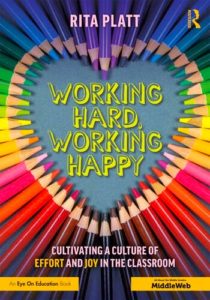Laughing and Learning: Create a Culture of Joy
A MiddleWeb Blog

Her mom asks, “What did you learn at school today”
The kid replies, “Not enough. I have to go back tomorrow!”
Teacher: You weren’t here yesterday. You missed school.
Student: No, I didn’t miss it one bit!
Okay, so maybe these aren’t the funniest teacher jokes. But, they made me smile and I hope they made you smile too.
Smiling and laughter matter. In fact, they matter a lot because they breed joy. Recently, I read the tweet below from school climate guru, Peter DeWitt. He says, in essence, that school climate isn’t another thing on our plates – it is the plate – the foundation that supports all we do.

Join me in pledging to bring smiles and laughter to our classroom cultures until the halls ring with joy.
The Case for Joy
Joyful classroom environments help students learn, and that’s the whole point, right?! Studies show that joy matters in school.
- Dopamine is released when we experience joy; it acts like an intrinsic reward system. One neuroscientist refers to dopamine as a “save button” because when it is released, it provokes development of long-term memory.
- When humor in interjected into lessons students are more likely to retain what they’ve learned and are likely to be less stressed and more primed to be resilient.
- In classrooms that are perceived as fun, a sense of community is developed and students’ affective filters are lowered, making them more susceptible to new ideas, taking risks, and learning.
Skillfully Joyful
What’s fun for one person may not be fun for the next. The concept of a joyful classroom is deceptively complex. In hopes of working together to increase the culture of joy in our classrooms, let’s focus on three things: Smiling often, laughing more, and helping students to do the same.
Let’s be honest, we don’t always feel joyful at school. Sometimes a smile is hard to find, never mind honest laughter. And most teachers know that students often reflect the attitudes we put out. Given the science, we want our students to be joyful, and thus we must learn to skillfully cultivate joy ourselves. And, hey, teachers deserve a joyful environment too! It’s not only the kids who are in school for a large part of every day.
Here are some tips for getting your happy on.
1. Don’t feel it? Fake it, until you make it.
Years ago I had an incredible mentor who helped me see my role as the culture leader in my classroom. Once, after a night spent bailing floodwater from my basement, I came to school tired and grumpy and ready to frown through the day. My mentor, who did not mince words, said, “It’s okay to feel grumpy and to be tired. It’s not okay for you to put that mood on your room full of kids.”

Don’t get me wrong, I’m not saying a fake smile is a cure for depression, or that it made me happier about my flooded basement. I am saying that during the workday, teachers have the chance to lift up or bring down our students. We must choose to lift them up. Smile. Laugh. Act as if.
2. Laugh at your own jokes.
Even when they’re not funny, jokes are fun! When I taught seventh grade language arts, I started each unit with a joke. For example, before I started a study of science fiction, I told the following joke:
So, yesterday, I went to visit my husband in his man-cave. It was a mess. Among the piles of papers, books, and balled up dirty laundry, I found an ugly creature lying dead on the floor. I asked my husband what it was. He said, “It’s an alien.” I replied, “Oh it must have been one of those brain-suckers. Too bad he found your room first. It looks like he starved to death!”
Again, perhaps not the funniest joke in the world, but it served its purpose. And in addition to the giggles, outright laughter (and, okay, some groans), I had every student’s eyes on me when I said, “Guess what genre we’re going to study next?”
Don’t know any jokes? Google them. In fact, stop reading this post, open another tab, and google a joke to start your upcoming units right now.
3. Play music and shake your groove thang.
When I feel boredom or exhaustion creeping into class, or when I see kids need to take a break, or I note a need to celebrate, I transform into DJ Crazy-Teacher.

4. YouTube it.
Cute babies, grumpy cats, and funny memes can all work wonders. It’s easy to find good stuff pretty quickly with Google Images and YouTube. Try this this funny verson of school rules with the Minions or this Kid Snippets on learning math.
5. Spread the good news.
One of the easiest and most effective ways to breed joy is to focus on the good in every student and emphasize successes. Keep your smartphone in your pocket and text or call a parent on the spot when a student does something wonderful. Similarly, reach out on Facebook, Instagram, or other social media platforms familiar to your community to tell them how great your students are. Quick messages like this mean a lot. Here are two I recently sent out, “Azalea rocked her science test today!” and “Ask Kenneth to tell you about the theme he came up with for Moby Dick, it’s BRILLIANT!”
Learning is the Bottom Line
Of course, it’s not all about sunshine and rainbows. At its very best, joy in the classroom serves to increase achievement. Almost anyone who knows me as a teacher knows that when it comes to learning I am hardcore. I hold my students to high standards just as I do myself. Students in my classes understand that demonstrating academic growth is the bottom line. Put in other words, as I tell my kids, smiles, laughter, and fun are a part of hard work, not the opposite of it.

Grandmas can be summed up as, “First veggies, then dessert!” When at all possible, the day-to-day work of learning should have dessertish-qualities, but my students know that if they want some joy-making craziness, they have to not only be on task and focused most of the time, but they also have to be ready to come right back into the learning zone when the song is over, the video finished, and the last joke is cracked.
Some years, I start by blowing up dozens of balloons and leaving them in the classroom. Then, I challenge my students to not touch them, saying, “I love a joyful, fun classroom. But, I also love learning. You are going to learn a lot this year. You’re also going to have fun. Today, I want to see how much self-control you have. That’s important for me to know before I let my fun-side kick in.”
Kids get the message right away and, for the most part, they leave the balloons alone. At the end of that first day, I explain Grandma’s Rule and in the last two minutes of that first day of school we go crazy throwing and bouncing balloons and filling our shared space with joy! For more ideas on helping students practice self-control, check out Larry Ferlazzo’s resource page.
Choose Joy
There are deeper ways to weave joy into learning than flashing a smile or telling a joke. Offering students voice and choice, integrating academic engagement strategies, and celebrating the whole child all come to mind.

Go back and reread the first joke. Notice that in it, the age-old question, “What did you learn at school today?” is asked. As a parent, I long ago ditched that question and replaced it with a new one, “Did you laugh today?” If students are laughing, they are open to learning.
Did your students laugh today?

She currently is a school principal, teaches graduate courses for the Professional Development Institute and writes for We Teach We Learn. Rita’s book, Working Hard, Working Happy: Cultivating a Culture of Effort and Joy in the Classroom (Routledge/MiddleWeb) is full of more ideas for making school a happy place to be.


































Beautifully expressed! These are my sentiments, as well, and I am becoming better at demonstrating them to the kids!
Hedy! I am so glad that you enjoyed the article and feel the same way about a joyful classroom.
You bet! “School climate IS the plate.” Good suggestions.
Thanks, Mary!
Yes, yes, yes, Rita! Joy and engagement go hand in hand and lead to real student investment. This is a crucial component of honoring the needs of the whole child. This is a great back to school reminder!
I agree, Robert! I feel so terrible when I think of kiddos who do not have a joyful classroom to attend each day. I KNOW you provide that for your kids. Bless your heart!
Once you’ve done some work balancing control and fun, it’s much easier to interject the necessary joy! Katie Mcky taught me that if students can exhibit control, the teacher can throw in some wild fun. If the kids get a little wild, then the teacher has to turn up the control a bit. Keeping that in mind has made it so much easier and more comfortable for me to have a joyful classroom. Thanks for this article Rita.
I love how you put that, Marcia, “if the kids get a little wild…turn up the control a bit…” That’ what I was trying to say, but not as effectively as you did. Thanks!
Joy and engagement go hand in hand and lead to real student investment. This is a crucial component of honoring the needs of the whole child. I KNOW you provide that for your kids.
What a nice note, Roy! Thank you!
What a joyful piece, Rita! Yes, I chose JOY!
Yay! Thanks, Valentina!
Thanks for sharing this blog with me, Rita! I love the idea of spreading joy into my classroom. Your resources and ideas will be put to great use with my fifth graders!
So happy to hear that!
Thanks for all the great tips! I really love the idea of using the balloons in the beginning of the year. I think I will have to try that one for next school year. :)
Oh! I hope you try it! If you do, PLEASE let me know how it goes, Sarah! HUGS!
Rita this is a wonderful article! I know for a fact that smiling, singing,and having fun in a language classroom is crucial to learning! I love all the ideas you give in this article. I will definitely share out!
So glad, Carmen! I agree, without fun learning is less likely to happen and really, the bottom line is JOY is what life is all about. I love that you make it a daily part of your time spent with students.
Very happy you shared this blog with me! I really enjoyed this piece :) I love the words from your mentor. When you really break it all down, the teacher is the core of the classroom, and what (s)he demonstrates to the students is going to be what the students take away. I You’ve opened my eyes a bit more in that even when the teacher is having an off day, it’s out JOB to create a happy environment for our students. #cultureleader
I am so happy that you enjoyed the post, Rebecca! I love what you say about how “what [the teacher] demonstrates to the students is going to be what the students take away.” #TRUTH
A colleague of mine always says, “Attitude reflects!” Let’s make sure joy is what we put out in the world so that joy is what is reflected back to us.
Love this!! Adding this to my favorites and I plan to share it with my department next week! Thank you!
So happy to hear that, Suzen! I sure loved writing it!
I think there are a lot of ways make learning effective but the most effective way is to make it fun. Learner will sometimes find the topic too boring that their brain might never grasp it or it will just be forgotten right away. So to make the learning stick to the mind of the learner is to make it fun and memorable. Appealing to the emotion makes it memorable. If the teacher could find a way to make this strategy works, then the learner will really learn a lot.
AMEN!
I could not think of a more appropriate time to read this article than the night before going back to work after winter break! I love the energy that is brought into this article. i can only IMAGINE what the energy in your class is like! I can’t wait to read more blog posts like this one! Thank you for sharing this.
I am so happy that you enjoyed it Andreia! Thank you for taking the time to comment.
Thank you so much for sharing this article with me. Building joy in my classroom has definitely become my top priority and I appreciate the many tips in this article.
Yay! JOY should be a top priority! Good for you!
There are great ideas in this article! Thanks for the resource! It’s great knowing I’m not the only one who has to fake it sometimes!
Thanks for sharing! I enjoyed these great pointers and will definitely give them a shot – especially grandma’s rule.
I am so glad you found it helpful!
Thanks for sharing the article. There are definitely days where I need to “force” myself to find the joy. Laughing together with my students at the silliest things helps us all make it through those tough days.
Yes! Sometimes I have to get on YouTube and watch a couple of funny videos to “force” it…but the joy always comes…
Thanks for sharing such great tips! I enjoy reading about new ways to make my students smile! One thing I do each day to share joy in my class is change me screen saver. I do jokes, funny images, inspirational quotes, etc. The kids enjoy coming in each day to see what I have posted for the day.
Oh! I love that! The school secretary sends us all a funny meme every day and it almost always makes me laugh!
I would have loved to be in your classroom as a student! I feel my teaching style is very similar to yours. I love to have fun and help the students find joy in everyday little activities. Once, during the holidays, we had an Elf on the Shelf. Each day the students came in, they would find a new and exciting thing those “elves” did. One day the students came in to a snowball fight and room toilet papered. This all ended being being part of the Math lessons with estimation, measurement for distance, and weight. Students that are in high school will still come to me and tell me the happy memories they had from being in my 4th grade class. And yes, learning still took place. I had a very good record of many of my students later on becoming senior Valedictorians!
I LOVE that! How fun!!!
I loved your article. I laugh everyday at school. Work hard, play hard!! is our class moto!!
Thank you for sharing this! A great reminder with the details… it reminds me to be in the present moment- to let go of whatever I may be burdened with (personally or professionally) and to BE of JOY.
Here’s a reminder when someone says, “What time is it?” Answer: “The Perfect Time”- focusing myself and everyone else to the present moment with a smile.
Oh! I LOVE THIS!!!!! I am stealing, “The perfect time!” Thank you!
I love your article. I like to have fun when I’m teaching and most important I like my students to have fun in my class. I love the joke idea :)
Great thoughts to ponder as we begin a new year. Thanks for the article!
I love this article. Thanks for sharing!
Thank you for sharing your JOY! I really enjoyed this article. You gave me a reminder to laugh and spread good news!
Thank you for this important article. I whole heartedly agree that a joyful classroom promotes learning.
With such an emphasis on testing I see too many teachers who have lost the importance of joy in their classrooms! It is so important, like you wrote, to understand how important joy is and its positive affect
on learning!
I feel like I found a kindred spirit in you. Love all the tips and advice on having a rigorous classroom that is still considered fun and engaging to students. I think this year with virtual learning has taken a toll on many of us educators… we need that light to be lit again so we can do what we do best.. instilling a love for learning and helping students succeed. Thanks for reminding me how important JOY is.
Thank you for sharing your website with me. It is great! A little bit of laughter in our classrooms make a positive student-teacher relationship. Let’s remember “ laughter boosts the immune system! Love the question at the end : Did your students laugh today?
Love this! It’s a wonderful reminder!
This was an amazing article. I love to spread joy throughout my class whenever possible. These are some amazing tips.
Thanks for sending me this. I absolutely agree. I am going to try and tell more jokes.
I loved the article, Rita! It can be work trying to find that balance between good classroom management and creating a fun, dynamic learning environment. I noticed that students who enjoy school become active participants in the learning activities and generally are more successful.
Thanks for sharing the link in my PDI assignment. I enjoyed the article and agree. It’s a fine line to walk, but it is the line the most successful teachers are able to balance. I think asking the kids, Did you laugh today?, as even part of an exit ticket with their math problems, might be more telling than the solutions to the problems themselves…or…might present quite the association between who understood and absorbed the concept and who did not.
Just read this article and thought what a great reminder to remember that joy filled spaces are learning places. I love to laugh and have fun connecting with my students. The classes and teachers that I remember the most and had the most impact on me were the ones where the teacher knew how to have fun throughout the day.
Yes! Sometimes the laughs won’t come easily but the impact of a joyful class is worth it!
Thank you! Inspiring!
I don’t know how I missed this article the first time around, but thank goodness I found it today! What a masterful piece of advice for both new and veteran teachers. I think sometimes we need to give each other permission to be funny and have fun, and you provide the blueprint to get it started. I had never hear the first day balloon idea before, but wow, I cannot wait to start sharing that with other teachers! I love your work, Rita, and I appreciate what you share with other educators!!!
Great article! Gotta go and find a joke for tomorrow’s class! Thank you:)
Awesome! agree and love! We need Joy to spread it. These are great ways to keep it going. Thank you!
Learning is the bottom line no matter how you get there! Spreading joy is the best way! I love your ideas!
This is full of great reminders and suggestions! I live with the Choose Joy motto! Thank you for sharing this with me!
I am in your class right now and you are spot on here! I do love having fun with my students and I believe music is a welcome sound to a middle school student’s ears!
Thanks for sharing this. As I prepare to head back to school, I needed to be reminded about the importance of creating JOY in my classroom.
Thanks Rita!
Thank you! This is truly inspiring. Creating a classroom culture of joy is such an important foundation for meaningful learning. I’m always looking for ways to bring more positivity and engagement into my science classroom, so I’m excited to explore and build on some of your ideas!